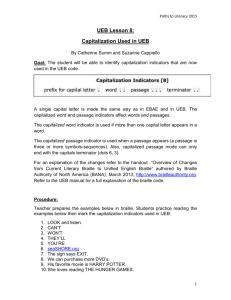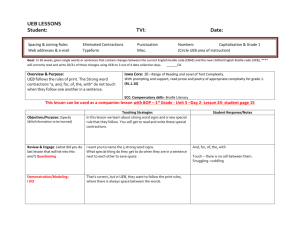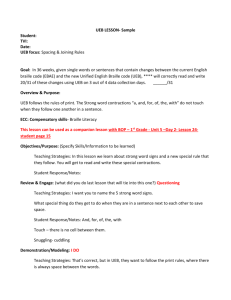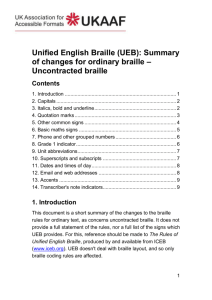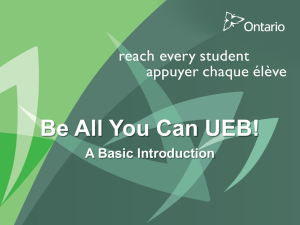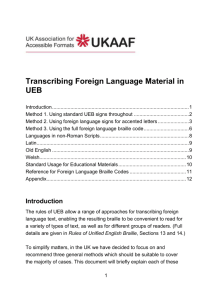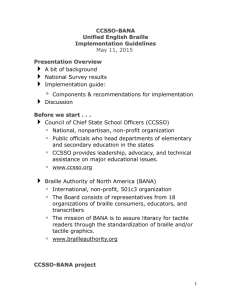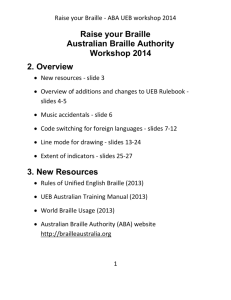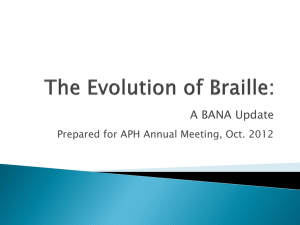Implementing UEB in the UK
advertisement
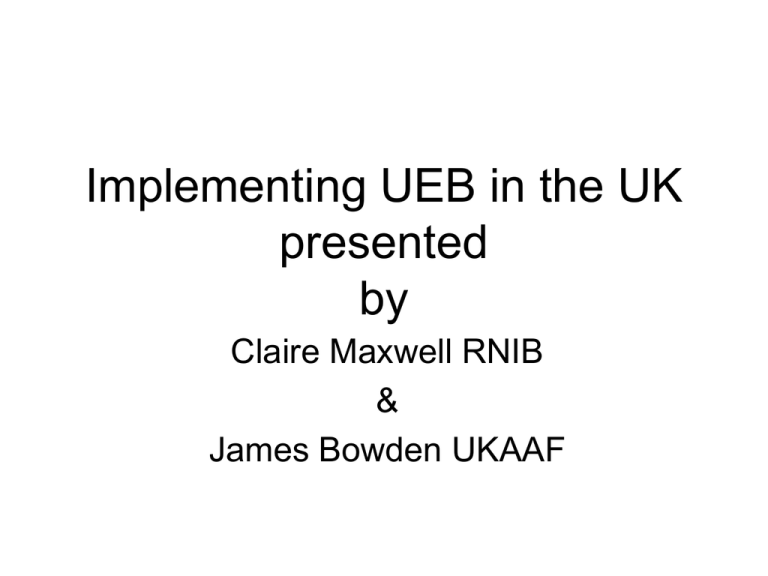
Implementing UEB in the UK presented by Claire Maxwell RNIB & James Bowden UKAAF The main differences between Unified English Braille (UEB) and Standard English Braille (SEB) Unified English Braille (UEB) Summary of changes for ordinary braille • Introductions • Draft version of summary document • Braille signs now only represent one character – removing ambiguity Some familiar contractions that are no longer used in UEB ble com dd ation ally o’clock to into by unable come daddy na;n tally #c o'clock to "w 9to pieces by !n Further examples addition table addi;n table station /a;n into space 9to space the toddler tumbled ! Toddl] tumbl$ Sequencing has been abolished in UEB Sequencing All of these wordsigns must now be spaced from each other: and for of the with a & = ( ! ) a Examples for the time being = ! "t ;+ of and for the people ( & = ! p and with the result & ) ! result Use of the ence contraction In words containing “enced” or “encer” the contraction ence is used rather than en then ed or er silencer sil;er silenced sil;ed Lower wordsigns Lower wordsigns such as in, be and his can be used in contact with capital indicators or terminators even if the string does not include an upper sign. Be Calm! ,2 ,calm6 His head ,8 h1d The ea contraction The ea contraction is now permissible in words like caveat, genealogy, Montreal, pancreas, Neapolitan and Seattle. The ea contraction can also be used as part of diphthongs as in Judaean. Contractions and the oblique stroke The oblique stroke is not treated as a word boundary for some of the contraction rules in UEB. Simple upper wordsigns (such as but and can) or lower groupsigns (such as be, con and dis) cannot be used in contact with the oblique stroke. Examples print/audio pr9t_/audio above/below above_/below quite/very quite_/v]y Capitals Capital indicators are the same as for SEB. Symbol , Word ,, Passage ,,, Terminator ,' Examples LEFT-HAND ,,left-,,h& I AM HERE! ,,,I am "h6,' NORTH/SOUTH ,,nor?_/,,s\? Italics, bold and underline UEB has separate indicators for italics, bold and underline. Italic Bold Underline symbol .2 ^2 _2 word .1 ^1 _1 passage .7 ^7 _7 terminator .' ^' _' Examples books book^2s reading The Times r1d+ .1,! .1,"ts avant-garde .1avant-g>de February _1,febru>y Quotation marks Outer quotation marks have generic braille signs in UEB (the same as SEB) regardless of what is used in print. Inner quotation marks have new signs in UEB Outer: 8 0 Inner single: ,8 ,0 Inner double: ^8 ^0 Email and web addresses Email and web addresses are treated as normal text. mark@trade123.co.uk m>k@atrade#abc4;co4uk friend@rogers.com fri5d@arog]s4com ukaaf.org ukaaf4org Training and resources What happens next? Academic year 2012/13 • • • • Funding issues Development of basic reference materials Raise awareness of UEB Develop course to upgrade from SEB to UEB 22 Academic year 2013/14 • Updating of production software • Update braille learning courses (prioritising those for younger learners) • Library titles to be converted to UEB or purchased • Workshops for teachers on upgrading to UEB 23 Academic year 2014/15 • Children's braille courses complete. Conversion of adult courses begins • All children's books and magazines being produced in UEB • Second strand of workshops for teachers dealing with technical subjects in UEB • Taster sessions etc for general readers RNIB certificated course in 2nd grade Braille to include UEB 24 Academic year 2015 to 2016 • Most school children should be using literary braille by year end • State exams in SEB and UEB for the last year (apart from some agreed technical subjects) • All general production of magazines and books in UEB 25 When to start teaching UEB 26 Resources and References www.ukaaf.org Or enquiries@ukaaf.org http://www.iceb.org/ 27 Thank you for listening
